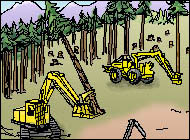Logging eTool
By many measures, Logging is the most hazardous industry in the United States, particularly the activity of manual felling. This eTool outlines the required and recommended work practices that may reduce logging hazards. Navigate through this eTool by clicking on the specific item displayed in the pictures or go through the tutorial lessons contained in the User Guide.
See OSHA's Workers' Rights page for more information on rights and protections.
*eTools are "stand-alone," illustrated, Web-based training tools on occupational safety and health topics. As indicated in the disclaimer, eTools do not create new OSHA requirements.


 Manual Operations
Manual Operations Mechanical Operations
Mechanical Operations